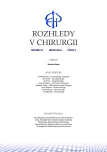-
Medical journals
- Career
Quality of nephrolithiasis surgical treatment – what is it influenced by?
Authors: V. Kováčik 1,2; M. Maciak 3; P. Bujdák 2,4; V. Baláž 1; R. Školka 5; M. Rusňák 6
Authors‘ workplace: II. Urologická klinika Slovenskej zdravotníckej univerzity, FNsP F. D. Roosevelta Banská Bystrica 1; LF Slovenskej zdravotníckej univerzity v Bratislave 2; Katedra pravděpodobnosti a matematické statistiky, Matematicko-fyzikální fakulta Univerzity Karlovy, Praha 3; Urologická klinika Slovenskej zdravotníckej univerzity v Bratislave 4; II. Gynekologicko-pôrodnícka klinika Slovenskej zdravotníckej univerzity, FNsP F. D. Roosevelta Banská Bystrica 5; Oddelenie Cievnej chirurgie, FNsP F. D. Roosevelta Banská Bystrica 6
Published in: Rozhl. Chir., 2018, roč. 97, č. 2, s. 82-87.
Category: Original articles
Overview
Introduction:
Identifying factors effecting the quality of nephrolithiasis surgical treatment could improve medical care for patients suffering from kidney stone disease. The objective of the article is to identify factors influencing reintervention rate after surgical treatment of kidney stone disease either by percutaneous nephrolitholapaxy or flexible ureterorenoscopy.Method:
A retrospective study was conducted on 149 patients who underwent a surgery for a kidney stone disease at the Urological department of F.D. Roosevelt hospital Banská Bystrica from January 2015 till June 2015. The cohort included 60 women at average age of 57 (range 28–91) and 89 men at average age of 58 (range 30–92). Patients were treated by percutaneous litholapaxy (67 cases) and flexible ureterorenoscopy (82 cases, including 72 using dusting technique). Factors with potential influence on probability of repeated intervention during following 12 months have been studied and statistically analyzed. For the statistical analysis we used the generalized linear regression framework (GLM − Generalized Linear Model) with the stepwise forward modeling approach.Results:
Using the significance level of 5% the statistically significant factors affecting the probability of the re-intervention for ipsilateral kidney stone disease are the stone size (p-value 0.0035) and the postoperative stone free status (p-value 0.0418). Other studied factors as demographical data (age, gender), surgical method (percutaneous nephrolitolapaxy or flexible ureterorenoscopy), stone count, postoperative draining system (nefrostomy or JJ stent) did not have any statistically significant impact.Conclusion:
Patients could benefit from early diagnosis which could lead to earlier identification of smaller stones. Perfect operative technique with intraoperative achievement of stone free status is important to lower the need of repeated intervention.Key words:
kidney stone disease – reintervention − residual fragments
Sources
1. Al-Kohlany KM, Shokeir AA, Mosbah A, et al. Treatment of complete staghorn stones: a prospective randomized comparison of open surgery versus percutaneous nephrolithotomy. J Urol 2005;173 : 469–73.
2. Türk C, Knoll T, Petrik A, et al. EAU Guidelines on Urolithiasis. In: EAU Guidelines, edition presented at the annual EAU Congress Munich 2016.
3. Wright A, Rukin N, Smith D, et al., „Mini, ultra, micro“ – nomenclature and cost of these new minimally invasive percutaneous nephrolithotomy (PCNL) techniques, Ther Adv Urol 2016;8 : 142–6.
4. Grasso M, Fishman AI, Alexander B. Ureteropyeloscopic management of upper urinary tract calculi. In: Grasso M, Goldfarb D. Urinary Stones – Medical and surgical management. USA, Wiley Blackwell 2014;20 : 243−63.
5. Ruhayel Y, Tepeler A, Dabestani S, et al. Tract sizes in miniaturized percutaneous nephrolithotomy: A systematic review from the European Association of Urology Urolithiasis Guidelines Panel. Eur Urol 2017;72 : 320−35. Available from: https://www.ncbi.nlm.nih.gov/pubmed/28237786
6. Burgher A, Beman M, Holtzman JL, et al. Progression of nephrolithiasis: long-term outcomes with observation of asymptomatic calculi. J Endourol 2004;18 : 534−9.
7. Khaitan A , Gupta PN, Hemal AK, et al. Post-ESWL, clinically insignificant residual stones: reality or myth? Urology 2002;59 : 20−4.
8. Cohen J, Cohen S, Grasso M. Ureteropyeloscopic treatment of large, complex intrarenal and proximal ureteral calculi. BJU Int 2013;111:E127−31.
9. Giusti G, Proietti S, Villa L, et a. Current standard technique for modern flexible ureteroscopy: Tips and tricks. Eur Urol 2016;70 : 188−94.
10. Bryniarski P, Paradysz A, Zyczkowski A, et al. A randomized controlled study to analyze the safety and efficacy of percutaneous nephrolithotripsy and retrograde intrarenal surgery in the management of renal stones more than 2 m in diameter. J Endourol 2012;26 : 52−7.
11. De S, Autorino R, Kim FJ. Percutaneous nephrolithotomy versus retrograde intrarenal surgery: a systematic review and meta-analysis. European urology 2015;67 : 125−37.
12. Kirac M, Bozkurt ÖF, Tunc L, et al. Comparison of retrograde intrarenal surgery and mini-percutaneous nephrolithotomy in management of lower-pole renal stones with a diameter of smaller than 15 m. Urolithiasis 2013;4 : 241−6.
13. Oitchayomi A, Doerfler A, Le Gal S, et al. Flexible and rigid ureteroscopy in outpatient surgery. BMC Urol 2016;16 : 6.
14. Armitage JN, Withington J, van der Meulen J, et al. Percutaneous nephrolithotomy in England: practice and outcomes described in the Hospital Episode Statistics database. BJU Int 2014;113 : 777−820.
Labels
Surgery Orthopaedics Trauma surgery
Article was published inPerspectives in Surgery

2018 Issue 2-
All articles in this issue
- Classification of posterior malleolar fractures in ankle fractures
- Fractures of the fifth metatarsal base
- Anatomy of fractures of the inferior scapular angle
- Quality of nephrolithiasis surgical treatment – what is it influenced by?
- Our experience with left-sided retroperitoneal approach to resection of abdominal aortic aneurysm
- The effect of circulating tumor cells on the survival of patients with pancreatic cancer − 5-year results
- Classification of scapular body fractures
- Perspectives in Surgery
- Journal archive
- Current issue
- Online only
- About the journal
Most read in this issue- Fractures of the fifth metatarsal base
- Classification of posterior malleolar fractures in ankle fractures
- Classification of scapular body fractures
- Anatomy of fractures of the inferior scapular angle
Login#ADS_BOTTOM_SCRIPTS#Forgotten passwordEnter the email address that you registered with. We will send you instructions on how to set a new password.
- Career

